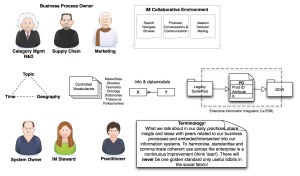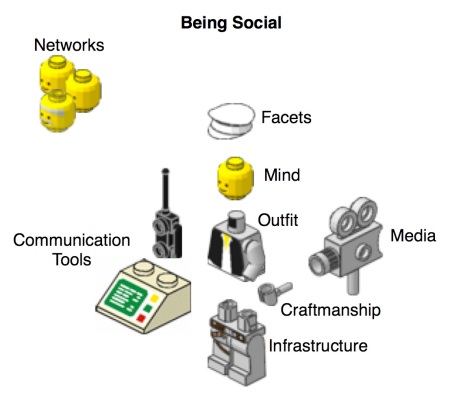The wheels keep on turning, and we as world citizens do embark into consumerism ever so eagerly. What to do with all the stuff we get in our daily foraging?
Digital Infrastructures have set the prefix of e- in front of every possible term, to emphasize the reasoning of electronic or digital. Question, does this really make sense today? The picture is really blurred. Where does the real world and the digital world end, where does means met ends? When we Internet savvy folks, speak of Internet of things do this echo in the minds-sets of our less connected peer human beings?
On a philosophical angle we buy things either to survive or to boost our personas with stuff related to who we think we are in the social fabric of life. Leaving a signal to other humans that I consume and because of this I am 😉
Hence, Commerce is a Commerce is a Commerce is a Commerce transformed from the simple but yet omnipresent poem by G. Stein 1913. When traditional retail, brick and mortar, meets e-commerce on the social battle field what is the outcome for the everyday consumer? Well one could name tag this x-channel commerce, where intertwingularity really starts to happen.
Anybody who either have undertaken some kind of business school or baseline marketing diploma knows for sure there are some elements that one just do not take away that easily to make an prosperous business. Same goes for us who have been engaged in entrepreneurship in a small retail or local grocery store. Know your customers! Engage with them on their grounds, invite them to a conversation so you as a provider are able to align your brick and mortar store front and shelves with goods (ends) that meet needs. Second to this, secure a feasible supply to have your store up and running.
The disruptive technology leap with the digital infrastructures, relates to information flows and the social life dealing with this information. Hence in a less open environment with constraints in the information supply, we just either had to comply with the options given, and trust the service provider. Or tinker to find pragmatic solutions to a broken system, as the folks in former eastern Europe had to do due to policy makers with twisted minds. Today in the modern big city life, we all have devices that gives us instant access to information when needed. An upper-hand for the consumer. Power relations have slightly changed the ballpark. Or maybe not? In a local setting with only one ‘Store’ the dealer had to know the demand and personally listen to all locals. We are rather getting back to business, as it emerged on the local marketplace or bazaar still omnipresent in many countries.
e-Commerce pains?
Well first and last… the churn rate to buy stuff when they have entered into the shop is between 2-4% on average. If they find the store in the first place that is! Many users do a quick search using either aggregation measure (Google, Pricerunner) where they get a decent overview, window shopping. All these aggregator services tries to tie some extra value with enhancements or schemas on-top of the unstructured world. Emerging ways of get semantics into this play have been in the loop for 15 years, and we are seeing this mashup economy growing daily and standards being put into action. Second how to curate a nice storefront that is compelling, easy to navigate and vibrant with goods and services to the users preferences and liking? When the information flow back-end with aggregation, integration more reflect staggering data mazes from all the suppliers? Topping this easy to pay! Here still many online stores have über-complex schemas. The x-commerce platform using Ebay/Paypal or Klarna from Sweden are some possible solutions to this threshold. And lastly the social interaction both in term of delivery, service provided and the show-off persona attribute 😉 My mind started to remember the Internet bombastic e-commerce failures, like Boo. Where users hardly could enter the store due to UX from hell, and those who got to the cashier couldn’t pay. Lastly the few bespoken people who actually managed to buy something had hard time getting their stuff!
Brick and mortar retail have not gone out of business, ask IKEA founder Ingvar Kamprad. If they had the same churn rate for all people driving to their sites and entering the store as the eCommerce folks have. He wouldn’t been on the list of richest in the world. Even the times you visit their site only to get your moneys back for a broken or dysfunctional goods. You can’t resist to take a peek-view into the store and find yourself buying even more. The same goes for food-stores. No one enters them without buying stuff! That’s why we spend time and effort to go there in the first place.
The frontier of eCommerce have realised this, and done their utmost to lure us firstly into the store through SEO, banners and whathaveyous. Second have a curation process that makes their store sticky, mimic real world experience. It is not as simple as copy the IKEA model, given that you are virtually not present in their store. Lack of sensory triggers! Might improve in 3D worlds with extra-embodied gadgets in near future. The most engaging experiences have basically a content factory with people infusing contextual data to the goods. Improve the appearance and findability across both their own site and in their value network. As the i.e. the fast growing Nelly.com from Sweden.
When you navigate in the store as in IKEA you follow a known path. Well designed so your sensory wayfinding skills don’t make you feel lost. Navigate any eCommerce site that lacks proper and sound Information Architecture and you instantly feel stressed and usually leave before even reaching for the cashier icon. Ask my dear wife who really loves to ‘shop’ compared to me who get the same mall-lost-in-shopping-hell-syndrome in any brick and mortar setting. She trashes many sites within seconds! or rather milliseconds!! Non functional!!! even if she knows that the store hold the searched for goods.
What amazes me, is how bad many eCommerce sites have settled pragmatic organising principles to their content? Maybe a better Content Choreograph assigned to this quest? Derived from this is the insufficient information supply chain. Data from their origin have so poor quality that not even the best automagic data-laundry helps. Why not crowdsource this obvious constraint to a viable and scalable business model? Shared responsibilities amongst all actors? Maybe a intermediary-data-laundry-model for data-flows could be of some help?
Without refined and enhanced raw-data, next step is basically impossible. Cross-channel commerce have to have sound organising principles, if not considering stove-pipes of different content factories in the back-end to a great cost! The improved digital assets needs to be smarter in all possible ways. When we talk about Internet of Things, as with RFID, NFC and other emerging standards within the UbiComp arena. Mobility First raises the bar for simplicity, cut the crap. Get to the point and deliver now.
The Social Creature
Living in a world of social means to capture our attention, it is no reason for a commerce provider to stay with a stale, stigmatised old school commerce model without the flavor of social intertwined all through. Some genres of products and services, do have better social flows, given that they are things people happily share. The travel and tourism industry is one of the business arenas, where user-generated-content really makes-sense. No one books a hotel without first checking out TripAdvisor, google maps/earth and many more sites to get a more nuanced picture of the planned trip. And both during your travel users annotate, share, curate and socialise around their experience, with a final reporting while being back home again. Same goes with fashion, and similar goods and services. Food chains have recepies. Whereas other stuff never have had any social sharing either in brick-and-mortar or eCommerce realm.
A greenfield commerce project
The notion of greenfield gives us a fun journey when we develop the cues for future commerce. No strings attached and build from ground-up with the soil and plants. Cultivate and nurture this new space. New entrants in the retail business have done some remarkable assertions. A people centric view to shopping, make the online and store visit a compelling journey that is seamless. C. Wonder have developed a new experience, where there are only personal shopping assistants, no cash register lines. The staff are passionate about the goods served, use mobile devices and pervasive and ubicomp setting to get handy information and data while guiding their clients in the store. All items sold have been enhanced with RFID. In the background there is a back-bone ERP, Supply Chain, CRM and whathaveyou cloud instance. That serves up real-time data and do manage the data in a completely new fashion.
What runs the show? DATA! all over the place but with a pragmatic, agile, and make-do feeling. Tinker, try, build and engage, review and improve. With proper organising principles to information and data. Here cloud service delivery models interplay with the ubicomp and mobile devices to create an ambient data service.
How to engage, well obviously social have been built into the spines of all core processes for the commerce set-up. As other retailers in this scene do. Have your Customer Service with Facebook feeds, and so forth. Online stores in any relevant social space. Basically let the users share their love (or hate!?) for the services and products. Have talented staff members intersected into the different levels of conversations. Social Business by design if you will 😉
Intelligence – pick my brain!
With the abundance of data flows in such a business design, big data. Tools and metrics to quickly align the practices on the floor have to be real-time. Consumer behaviour in all domains leave digital trails, combined with ‘smart things’ (RFID). But intelligence also implies tapping into the social conversations online pre- , during and post physical in store experience.
Intelligence also have to be the tuner to competitive outlook. Even if person centric service and human touch have a great impact on revenue, consumers still do have choices to make. So intelligent price-modelling and scanning will be key. These data backbone algorithms produce prices in constant flux 😉 Higher quality and experience taxes a bit more pricey level to things, but it still have to be on the same ballpark as the most low-cost option online. As with the Bazaar, where local store owners do mutual adjustment to prices, but then in the sales-pitch ‘haggle’ 😉



 Posted by Fredric Landqvist
Posted by Fredric Landqvist 


